Building SIP Raised Beds:
Self-Watering, Wicking Bed Design Principles
I can't keep silent any longer! After years of testing, I'm ready to share the most important elements that every self-watering, wicking bed needs to have in it. I've grown tired of incomplete or even faulty tutorials. So let's set things straight and get you on your way to building your own custom SIP raised bed!
This tutorial offers tips for designing your own self-watering planter or raised bed. These are sub-irrigated planters (SIP) which hold a water reservoir for passive watering. They could also be referred to as wicking beds because the soil wicks up water from below.
NOTE: This material applies to the type of wicking beds that use some sort of aeration screen, such as drain pipes. But it does not apply to raised beds that use an entirely gravel sub-base or beds that are constructed with AquaBlox & sand. What are my thoughts on gravel? Click Here.
- How to Design Your Own SIP Raised Bed:
- What Dimensions to Use for a Wicking Bed?
- Setting Up the Water Reservoir
- What Type of Wood for SIP Garden Beds?
- What Type of Dirt for Wicking Beds?
- How to Set Up the Wicking Layer?
- Should You Use Sand or Gravel for Wicking Beds?
- Should You Add Mulch to Self-Watering Beds?
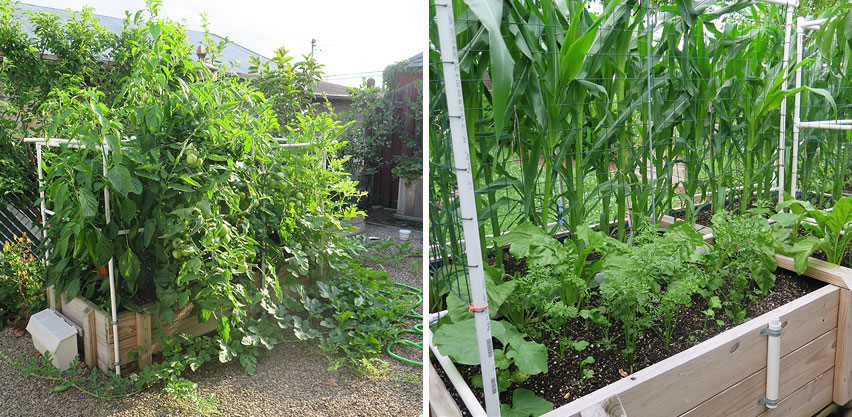
The wicking bed design featured in this tutorial can yield massive garden vegetables!
What Dimensions to Use for a Wicking Bed?
You have a lot of flexibility in the scale of your design. But there are certain key factors to consider as well.
LENGTH: Your bed can be as long as you want. Anything from 2 feet to 12 feet is pretty realistic. Just make sure your boards AND lining will be big enough.
WIDTH: You won't ever step in this bed. So you need to be able to reach all the way in. Maximum width should be 4 feet if you can access BOTH sides. Don't go any wider than 2 feet if you can only reach in from one side.
DEPTH: This is critical. I advise a depth of 16.5" (including the reservoir depth). That means 3 rows of 6" boards (5.5" actual width). Don't deviate too much from this. The more shallow the planter, the more overly saturated the soil will become. This could lead to root rot. Plus your plants' roots will be robbed of space for growth. Anything less than 12" is asking for trouble.
On the other hand, going deeper might start to reduce the ability of the soil to wick moisture all of the way to the top. I would suggest 24" as an absolute maximum. If the soil gets too dry at the top, you might need to irrigate it at the soil surface from time to time. To compensate, you might try to improve wicking by adding some coir or vermiculite to the mix.
A depth of 16.5" is an excellent reference point. That said, there are lots of variables. The physical properties of your potting mix will be a factor. How absorbent or porous is the mix? Climate is also worth considering. Cool, rainy climates will hinder the performance of shallow SIPs. And plant type also comes into play. Some plants HATE wet feet. Others do fine. Ultimately, going too deep is better than going too shallow when it comes to plant health.
Setting Up the Water Reservoir
WHAT TYPE OF LINING? Please do NOT use a 6 mil plastic lining or a tarp. The reservoir itself will hold up much better if you select a sturdier material. A fish-safe pond liner is the way to go. Although 20 mil might suffice, I advise trying 45 mil, especially if your climate includes freeze cycles. PVC should work ok, but I've been quite pleased with the EPDM liners. Look for it to say "Fish Safe". I bought mine off of Amazon.com.
4" PIPE SPACING: Select an appropriate number of 4" corrugated, perforated drain pipes. The spacing between the outer edges of each pipe should be a gap of 0.25" minimum up to 0.75" maximum. The pipes should not touch, but they should not be spaced loosely either.
SHOULD THE PIPES BE WRAPPED IN CLOTH? After YEARS of use, none of my SIP reservoir pipes have EVER filled up with mix! Even plant roots have trouble getting into the tiny slits on those pipes. Meanwhile, roots may pass right through any cloth or fabric lining you try to employ. So with this type of wicking bed, you don't need to waste your time or money. Remember, we aren't burying these in top soil where tiny particles are constantly washing through. These are under POTTING MIX not silt-laden soil.
OVERFLOW TUBE: Drill the hole(s) for your tube(s) so that the center is 3.25" up from the bottom. Alternately, you could use a rigid drain tube rather than the flexible PVC one shown in my video. Using a 7/8" spade drill bit, I was able to use a piece of 1/2" Schedule 40 PVC pipe which worked nicely.
NOTE: I don't seal the lining to the tube in my video. When the reservoir is filled to the max, you might observe a very slight seepage of water around the wood surrounding the overflow tube. This is not a big deal, but if you want to be extra thorough, you could use a "bulkhead fitting" when connecting you overflow tube to the liner. This would ensure that no water seeps out around the slit that is cut for the drain tube.
Video: Self-watering SIP Sub-irrigated Raised Bed Construction (How to Build)
Learn what you NEED to know when making your own Sub-irrigated Raised Bed.
What Type of Wood for SIP Garden Beds?
IS TREATED WOOD SAFE FOR VEGETABLES? Selecting the right wood for your wicking bed is matter of personal preference. But one thing to keep in mind: Depending on where you live, using treated lumber might not be a concern for you. In most places, chromated copper arsenate treatment (cca) is no longer sold to consumers. This applies to the US, Canada and EU. So if you live in these areas, you don't need to worry about arsenic exposure when using brand new treated wood. If you live in Australia, New Zealand or any other nation, then I suggest asking for a CCA alternative.
Of course, lining your bed with plastic creates a nice barrier between your lumber and the potting mix. But what if you just don't want treated, whether it contains arsenic or not? You could always opt for cypress, cedar or any naturally durable wood of your choice. Then there are also composite boards, cinder blocks or even corrugated metal panels. You have lots of options.
What Type of Dirt for Wicking Beds?
WHAT TYPE OF SOIL? It's very crucial that you do not treat this wicking bed like an in-ground plot. Do NOT use top soil or bagged compost / manure. Treat this like a large container. Fill it with a nice quality potting mix. You could buy a bagged retail mix in bulk. Or you could also buy raw components and make your own custom mix. Use things like peat moss, coir (coco), vermiculite, perlite or even a little pine bark mulch. Worm castings make a nice addition. The bulk of the mix should be peat moss / coir. You want something with strong wicking capability while also allowing for healthy aeration.
WHAT ABOUT MEL'S MIX? "Yeah, but. Yeah but!" I've gotten reports of people who have used 1/3 manure, 1/3 peat moss & 1/3 vermiculite (Mel's Mix) with great success in SIP containers. Years ago I ran a test in one of my 5 gallon SIP buckets. I can confirm that the mix had good wicking characteristics. The plants did quite well. So there's no doubt that Mel's Mix may work in a wicking bed. This is your bed and you can try what you want.
My primary concern with "Mel's Mix" is that there is no standard form of "compost." My compost had been homemade. It had loose, fine, woody particles in it. This helped quite well with pore-spacing and aeration. But someone else's Mel's Mix might be quite different. Store-bought manures and bagged composts often have very small particles. They can be very silty making them mucky when wet. Those fine particles could fill up the pore spaces in your mix. Remember, Mel's Mix doesn't call for perlite or bark products. So how will you ensure that the plant roots get good aeration?
WHY NO COMPOST / MANURE? Technically, I do use composts and manures in my SIPs. My bags of potting mix contain "composted forest products." When fertilizing, my organic blended fertilizers contain "chicken manure." But I always avoid those large manure / compost bags that are intended for inground application. I construct my SIP potting mixes from materials that can last for many years. Retail manures and compost bags may compact over time, cutting off oxygen in the root-zone. Once the soil fails and becomes anaerobic, plants can get root rot and eventually die. So I don't recommend them in self-watering planters. Instead, I stick with the guidelines that EarthBOX recommends. This has ensured longterm success, year after year, without any need to replace the wicking substrate.
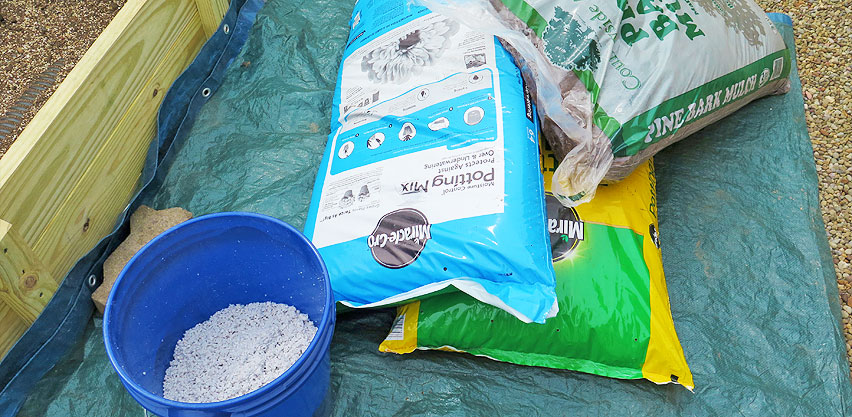
I often mix retail potting mix with pine bark and perlite to boost structural and aeration properties.
How to Set Up the Wicking Layer?
WHAT ABOUT THAT SPECIAL "WICKING" LAYER? I typically mix up a special layer of wicking mix that I use for the very bottom section of my SIPs. This is the mix that's stuffed in between the black corrugated perforated drain pipes. So what's the magical formula? Is this super critical? Rather than making a strict, hard fast rule, the idea is to offer a general guide.
If you're making a very small system and materials are hard to come by, you could probably just use the same potting mix that is applied to the top section and it should work ok. If you want to mix up a special wicking base, you can use peat moss / vermiculite / perlite at a ratio of 3:1:1. This is not set in stone. The ratio could be 1:1:1 and it would work well. Anything like that is fine. You could replace the peat moss with coir (coco). I like using this special mix, because it is easier to stuff in between the pipes, since the particles are small & uniform. Also, I'm not applying a nutrient rich potting mix in the very bottom of the box. Instead, the fancy potting mix is reserved for the upper layer.
In general, there's some flexibility here. When it comes to the wicking layer though, do not use wood or bark products. These will not wick well and they may cause air gaps as you try to pack the substrate around the pipes. Also, although peat moss is good at wicking, it does have a limitation. If peat moss becomes bone dry it becomes hydrophobic and actually REPELS water. So I never use pure peat moss in the bottom section since it could create a failure point if it happens to completely dry out.
Should You Use Sand or Gravel for Wicking Beds?
WHY I NEVER USE SAND OR GRAVEL: You have various options for wicking bed substrates. However, there are some materials that I absolutely do NOT recommend for a wicking base. I never use gravel or sand. I've written extensively about why I don't think gravel is the best option for wicking reservoirs. There are various forms of "gravel" that growers may use in their wicking beds. Some can be heavy to work with. Certain forms may be more costly or difficult to source. Compared to peat, coir, perlite and especially vermiculite, gravel simply does not wick as well.
Sand is a little better at wicking than gravel, but still not as good as the other substrate options. Sand, limestone gravel and all-purpose gravel are MUCH heavier materials. What if you ever need to move, break down or rebuild your system? Both sand and gravel bases will make the project much more difficult! It's not worth it. It's not that sand won't work in an SIP or wicking bed. But I've never seen a single argument for why sand is a superior option.
If you're buying your sand in bulk, you might be able to get it at a reasonable price. However, if you're stuck buying bags, sand can be pretty expensive. At my local Lowes, basic multi-purpose sand was $13.68 per cubic foot. Meanwhile a compressed bale of peat moss was only $8 per cubic foot. And remember, those bales can double in volume when opened up. Similarly, you can buy coco coir mix which expands to 2.5 cu ft, making it only $8.39 per cubic foot. I was able to buy bulk bags of perlite on Amazon for only $9.59 per cubic foot. On Amazon, vermiculite was only $12 per cubic foot and it's insanely water absorbent. Certainly in my area, sand is not an economical option.
Should You Add Mulch to Self-Watering Beds?
DO YOU NEED A PLASTIC COVER? Wicking garden systems do not require a cover. Including one is purely optional. Plastic covers block the exchange of gases between soil and atmosphere. They prevent you from harnessing natural rain water. They also make it hard for you to apply liquid root drench fertilizers. But there may be reasons why you want to use a cover. Perhaps, you are suffering from severe drought and there's no rain to harvest anyway. If you decide to try a plastic mulch / cover, then more power to you.
WHAT ARE OTHER MULCH OPTIONS? You could consider any type of organic mulching material. You might try applying a layer of straw. Then at the end of the grow season, simply pull off the straw and compost it. The same would apply to newspaper with grass clippings on top. Or instead, a thin layer of pine bark fines would work. In the Spring the old bark can be turned into the potting mix to refresh it before planting.
← READ MORE: What to Grow in SIPs?
READ MORE: How to Fertilize SIPs →


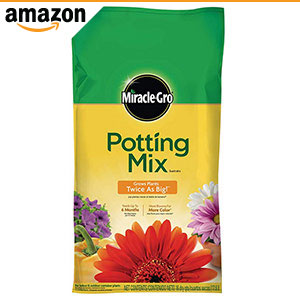
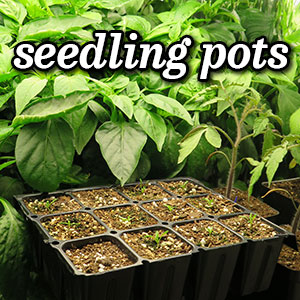
![no. Anti-GMO Tomato / Fish Meme [Gardening T-Shirt Design]](images/no.--Anti-GMO--Tomato--Fish--Meme-Tshirt-th.jpg)
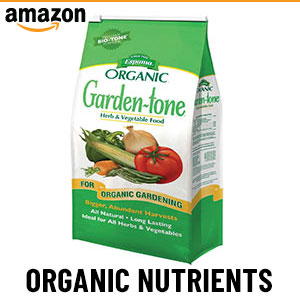
![Friends Don't Let Friends Throw Out Leaves [Gardening T-Shirt Design]](images/Friends-Dont-Let-Friends-Throw-Out-Leaves_Gardening-Tshirt-th.jpg)